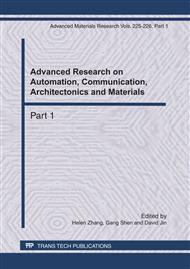p.364
p.368
p.372
p.377
p.381
p.385
p.390
p.395
p.399
GM(1,1) Model of Moving Average Operation to the Original Sequence and its Application
Abstract:
The grey forecasting model has been successfully adopted in various fields and its accuracy is closely related with the original data. Improving the smoothness of the original sequence can increase the accuracy of GM(1,1) model and many researchers have done such work about the original sequence improvement. The paper adopts moving average operation on the original sequence and gets the new sequence with good smoothness. In the process of the establishment of GM(1,1) model the paper adopts the integral method to get the background values and expand the equal interval into the unequal interval. The examples show the method can fit and predict the system development more accurately which provides a new way for the data processing.
Info:
Periodical:
Pages:
381-384
Citation:
Online since:
April 2011
Authors:
Price:
Сopyright:
© 2011 Trans Tech Publications Ltd. All Rights Reserved
Share:
Citation:


